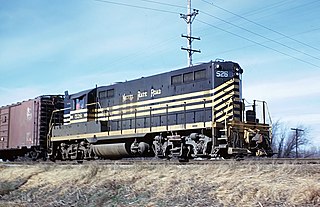
The New York, Chicago and St. Louis Railroad, abbreviated NYC&St.L, was a railroad that operated in the mid-central United States. Commonly referred to as the "Nickel Plate Road", the railroad served parts of the states of New York, Pennsylvania, Ohio, Indiana, Illinois, and Missouri. Its primary connections occurred in Buffalo, Chicago, Cincinnati, Cleveland, Indianapolis, St. Louis, and Toledo.
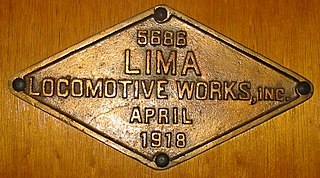
Lima Locomotive Works was an American firm that manufactured railroad locomotives from the 1870s through the 1950s. The company took the most distinctive part of its name from its main shop's location in Lima, Ohio. The shops were located between the Erie Railroad main line, the Baltimore & Ohio's Cincinnati-Toledo main line and the Nickel Plate Road main line and shops.

The Delaware-Lackawanna Railroad is a shortline railroad operating in Northeastern Pennsylvania, especially the Scranton area.
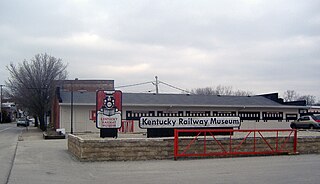
The Kentucky Railway Museum, now located in New Haven, Kentucky, United States, is a non-profit railroad museum dedicated to educating the public regarding the history and heritage of Kentucky's railroads and the people who built them. Originally created in 1954 in Louisville, Kentucky, the museum is at its third location, in extreme southern Nelson County. It is one of the oldest railroad stations in the United States.

Pere Marquette 1225 is a class "N-1" 2-8-4 "Berkshire" type steam locomotive built in October 1941 for the Pere Marquette Railway (PM) by Lima Locomotive Works (LLW) in Lima, Ohio. No. 1225 is one of two surviving Pere Marquette 2-8-4 locomotives, the other being 1223, which was on display at the Tri-Cities Historical Society near the ex-Grand Trunk Western (GTW) coaling tower in Grand Haven, Michigan, and both have the distinction of being the only surviving Pere Marquette steam locomotives left in preservation. No. 1225 was well known to be the basis for the locomotive used in the 2004 film The Polar Express, earning itself the nickname "The Real Polar Express."

Nickel Plate Road 765 is a class "S-2" 2-8-4 "Berkshire" type steam locomotive built for the New York, Chicago & St. Louis Railroad, commonly referred to as the "Nickel Plate Road". In 1963, No. 765, renumbered as 767, was donated to the city of Fort Wayne, Indiana, where it sat on display at the Lawton Park, while the real No. 767 was scrapped in Chicago in 1964.

The Indiana Transportation Museum is a railroad museum that was formerly located in the Forest Park neighborhood of Noblesville, Indiana, United States. It owns a variety of preserved railroad equipment, some of which still operate today. ITM is currently Located in Logansport, Indiana.
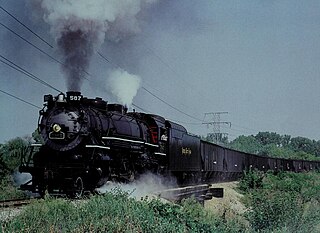
Nickel Plate Road 587 is a 2-8-2 type USRA Light Mikado steam locomotive built in September 1918 by the Baldwin Locomotive Works for the Lake Erie and Western Railroad as its No. 5541. In 1923, the LE&W was merged into the New York, Chicago and St. Louis Railroad, commonly referred to as the "Nickel Plate Road", and allocated 587 as its new number in 1924. In 2003, the locomotive was being restored by the Indiana Transportation Museum in Noblesville, Indiana. However in 2018, the museum was being moved to Logansport, Indiana, forcing No. 587 to be stored in Ravenna, Kentucky by the Kentucky Steam Heritage Corp. Since its arrival in Kentucky NKP 587 has been sold by Indiana Transportation Museum to a private individual who will remain anonymous until more information is released at a later point. There are plans to continue the locomotive restoration, but if and when that will happen is unknown. It was listed on the National Register of Historic Places in 1984, but was delisted on November 15, 2021.

Nickel Plate Road 779 is a 2-8-4 or "Berkshire" type steam locomotive built for the New York, Chicago and St. Louis Railroad, completed on May 13, 1949, for use on fast freight trains. It was the last new steam locomotive to be delivered to the Nickel Plate Road, and alongside L&N 1991, another 2-8-4 for the Louisville and Nashville, is the last of 36 steam engines completed by Lima-Hamilton from 1947 to 1949, and the final 2-8-4 locomotive on standard gauge completed in the world. L-H's first diesel, A-3080 demonstrator #1000 was completed the same day as #779. NKP also received the first production A-3080, NKP #305, one of 4 delivered by Lima-Hamilton in 1949.

A "Berkshire" type steam locomotive refers to a steam locomotive built with a 2-8-4 wheel configuration. The design was initially intended to improve on the USRA Mikado design (2-8-2), which was deemed to lack sufficient speed and horsepower. That was overcome by the inclusion of a larger, 100-square-foot (9.3 m2) firebox, requiring an extra trailing axle, giving the locomotive its distinctive 2-8-4 wheel arrangement.

Nickel Plate Road 759 is a class "S-2" 2-8-4 "Berkshire" type steam locomotive built in 1944 by the Lima Locomotive Works in Lima, Ohio as a member of the S-2 class for the New York, Chicago & St. Louis Railroad, commonly referred to as the "Nickel Plate Road". Built as a fast freight locomotive, No. 759 served the Nickel Plate until being retired in 1959 and placed into storage. In 1965, No. 759 was purchased by F. Nelson Blount for display in his Steamtown, U.S.A. collection in North Walpole, New Hampshire. The locomotive was restored to operating condition in 1967 by New York commodity broker Ross Rowland for use in hauling his Golden Spike Centennial Limited, a special commemorative train that celebrated the 100th anniversary of the completion of the Transcontinental Railroad in 1969. Afterwards, No. 759 pulled numerous excursions for Ross Rowland and Steamtown until being retired once more and placed back on display in 1977. As of 2023, the locomotive remains on static display at the Steamtown National Historic Site in Scranton, Pennsylvania, and sibling engine No. 765 continues to operate in mainline excursion service.
The 21st Century Steam program was conducted by the Norfolk Southern Railway from 2011 to 2015, featuring four classic steam locomotives pulling passenger excursions along Norfolk Southern rails in the eastern United States. The last train was to be Southern 4501's Piedmont Limited excursion trip from Atlanta, Georgia, to Toccoa, Georgia, but cancelled on October 1 due to Hurricane Joaquin.

Chesapeake and Ohio Railway 2716 is a class "K-4" 2-8-4 "Kanawha" (Berkshire) type steam locomotive built in 1943 by the American Locomotive Company (ALCO) for the Chesapeake and Ohio Railway (C&O). While most railroads referred to these 2-8-4 type locomotives as Berkshires, the C&O referred to them as Kanawhas after the Kanawha River, which flows through West Virginia. Used as a dual service locomotive, No. 2716 and its classmates served the C&O in a variety of duties until being retired from revenue service in 1956.

The Varsity was a passenger train operated by the Chicago, Milwaukee, St. Paul & Pacific Railroad over a 140-mile route between Chicago and Madison, Wisconsin.

Nickel Plate Road No. 763 is a class "S-2" 2-8-4 "Berkshire" type steam locomotive. It was built in August 1944 by the Lima Locomotive Works in Lima, Ohio, as the ninth engine of its class. It is a high powered fast freight locomotive that carried perishables between Chicago and Buffalo, New York.

The Chesapeake and Ohio Railway's K-4 class were a group of ninety 2-8-4 steam locomotives purchased during and shortly after World War II. Unlike many other railroads in the United States, the C&O chose to nickname this class "Kanawha", after the river in West Virginia, rather than "Berkshire", after the region in New England.

The Louisville and Nashville M-1 was a class of forty-two 2-8-4 steam locomotives built during and after World War II as dual-service locomotives. They were nicknamed "Big Emmas" by crews and were built in three batches between 1942 and 1949.
Wabash Railroad No. 534, also known as Nancy, is the sole survivor of the B-7 class 0-6-0 switcher steam locomotive that was built by the American Locomotive Company in 1906. It was used by the Wabash as a yard switcher, until it was sold in 1954 to the Lake Erie and Fort Wayne Railroad as No. 1. After being retired in 1957, it was donated to Swinny Park in Fort Wayne, Indiana for static display. In 1984, it was purchased by the Fort Wayne Railroad Historical Society, which removed the locomotive from the park and relocated it to their locomotive shop in New Haven. The locomotive is undergoing restoration to operational condition while serving as an educational tool for the younger FWRHS members, as of 2023.
The Kentucky Steam Heritage Corporation (KSHCO) is a nonprofit organization based on the border between Irvine and Ravenna, Kentucky. The organization mainly focuses on the restoration of Chesapeake and Ohio K-4 2-8-4 steam locomotive No. 2716 along with other vintage railroad equipment. The organization has plans of turning the surrounding area into its own tourist attraction called the Kentucky Rail Heritage Center through a partnership with the R.J. Corman Railroad Group and CSX Transportation.
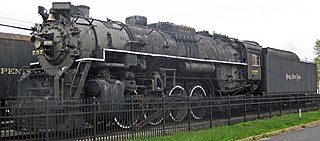
Nickel Plate Road 757 is a 2-8-4 Berkshire type steam locomotive built by the Lima Locomotive Works in Lima, Ohio for the Nickel Plate Road in 1944.
















